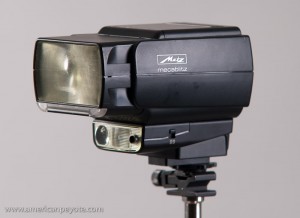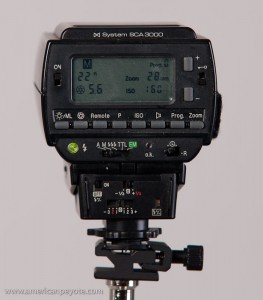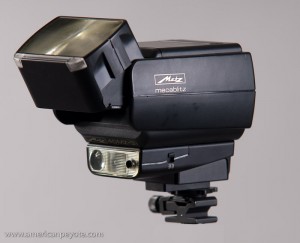Who is Metz?
When I started out with learning about lighting via the Strobist website, I was into the idea of picking up a couple of cheap Nikon SB24, 26, or 28 flashes on eBay. I soon realized however that this was a fool’s game as the Nikon SB line had been strobisized by David Hobby, and the used prices were over $100 for what should have been a cheap strobe to use with my cheap Chinese radio triggers. Then I asked myself a basic question, “Why buy a Nikon SB24/26/28 anyways?” What about a Metz?
The Nikon SB flashes are nice since they’re powerful and certain models can dial down their power to 1/125 or 1/256. This means you have a lot of flexibility with fine-tuning the exposure while shooting. By comparison, the Sunpak 383 and 120J (two of my favorites) only dial down to 1/16 and my Sony FL58 only does 1/32 in manual mode. After some searching I realized that Nikon wasn’t the only option for a quality flashes with a large power range and looked to Metz. Metz is a professional flash producer out of Germany. They’ve been making flashes since before I was born and produce a quality product that rivals the offerings of the camera makers. Metz flashes are generally designed to be workhorses for pro users who need to flash away all day at a wedding or some other event. This means they’re robust and designed to last a long time. Some even have user replaceable flash tubes. I reviewed the Metz offerings on the used market from the viewpoint of price versus performance, and eventually settled on the 40 MZ-3i.
 The Metz 40 MZ
The Metz 40 MZ
The Metz MECABLITZ 40 MZ-3i is a sweet flash (although now discontinued), and also offers a unique body design for off-camera flash work. Most shoe-mount camera flashes all look the same, the head points straight up in the normal position, and you have to angle it 90 degrees to shoot into an umbrella. The 40 MZ is designed exactly opposite to the norm. In the normal state it’s already pointing along the axis of the camera lens, which makes it perfect for mounting on a light stand and shooting into a softbox or umbrella (it’s more centered along the axis of the umbrella than a traditional flash). Additionally, the head tilts up, slightly down, plus it rotates around. So, basically with the 40 MZ you have a compact flash which is excellently designed for off-camera use with a large power range.
The MZ40 has all the features you want for off-camera (call it Strobist is you like) use. It has decent power, a guide number of 40 (ISO 100, 50mm), the flash power dials down to 1/256, you have a modeling light, stroboscopic function, zoom head (20mm to 105mm), external battery packs, etc. Additionally there’s an integrated wide angle diffuser, the the head pivots vertically between minus 13° to plus 90°, and can rotate 270°. The 40 MZ was produced in three main versions (I, II, III) plus an i designation. The 1 and 3 versions are basically the same except for some minor added functions. For off-camera manual use there’s really no difference.
 I picked up two 40 MZ-3i’s to shoot with on the used market (one from KEH and one from Adorama). There’s a battery pack you can buy or just shoot with 4 AA batteries. I recommend avoiding the battery packs since they’re old, and if you can get one it probably is run down and will hold fewer flashes than using the standard 4 AA’s. On the back of the flash you can control all the flash functions, which for me means leaving it on manual and adjusting the power level or zoom. If you have a compatible camera and SCA module you can use the TTL functions, but since the 40 MZ is rather old (from the days when film ruled), it’s possible that with your new digital camera the flash won’t work on anything but automatic or manual (no TTL) mode. In automatic mode the flash determines the proper exposure after you set the aperture and shutter speed on the control screen, in csae you want to use it on camera. You can check the function compatibility on the Metz website (a chart shows what functions work with different cameras).
I picked up two 40 MZ-3i’s to shoot with on the used market (one from KEH and one from Adorama). There’s a battery pack you can buy or just shoot with 4 AA batteries. I recommend avoiding the battery packs since they’re old, and if you can get one it probably is run down and will hold fewer flashes than using the standard 4 AA’s. On the back of the flash you can control all the flash functions, which for me means leaving it on manual and adjusting the power level or zoom. If you have a compatible camera and SCA module you can use the TTL functions, but since the 40 MZ is rather old (from the days when film ruled), it’s possible that with your new digital camera the flash won’t work on anything but automatic or manual (no TTL) mode. In automatic mode the flash determines the proper exposure after you set the aperture and shutter speed on the control screen, in csae you want to use it on camera. You can check the function compatibility on the Metz website (a chart shows what functions work with different cameras).
Metz builds two types of flashes, some specifically for certain camera makes like Canon, Nikon, Sony, etc. The other type they produce is adaptable, with separate SCA modules so a flash body can be used with just about any camera body you like (Canon, Nikon, Mamiya, Leica, etc.). The 40 MZ is this type, using SCA modules. This doesn’t really mean anything unless you want to use it on your camera. I have one 40 MZ with a standard shoe (one single pin) and I have one with the module for a Leica camera. Both types are easily triggered using a hotshoe adapter plugged into my Elinchrom Skyports or any other radio trigger.
 Using the 40 MZ
Using the 40 MZ
There’s little to say about shooting with it, because the 40 MZ is great to shoot with. It’s a workhorse flash with lots of power and a large power range. It’s compact and versatile for off- camera shooting. The combination of compactness and functionality makes it ideal for location shooting. I also mix the MZ40 with my studio strobes. For example, I might have an Elincrhom BxRi in a CreativeLight softbox paired with a Metz 40 in a Kacey Dish. The MZ40 acts as the control light to fine-tune shadow details while the BxRi lights most of the scene. This is what I did when I shot Oksana, the ability of the Metz to dial-down to a low power made the lighting work, whereas a more powerful flash like a Sunpak 383 would have washed out the fine details of Oksana.
On the other hand, the MZ 40 packs a lot of power, and is ideal when needing to balance the power of the sun on small shoots. This is what I did when shooting flowers on the terrace of my old apartment. The sky was blue, the sun was high, I was bored, and the tulips were in full bloom. So I setup the MZ40 dialed up to maximum power and used it with a weak-powered Contax TLA280 to create some awesome tulip pictures. When I’m traveling I easily drop a few MZ40’s into my Pelican 1510 case like Tetris blocks and pull them out as needed.
Buying a 40 MZ-3i
If you’re looking for a unique flash for off-camera use I recommend checking out the Metz 40 MZ series. On the used market the 40 MZ-3i generally goes for about the same amount (or less) as a Nikon SB, but since nobody except for you, me, and a couple other folks on the internet know about it, you’re not as likely to get into a bidding war on eBay. I bought the 3i version because it’s newer, but they cost more and if you’re looking for a bargain search for the 1i model.
The Gist
The MZ 40 was one of my first flashes, and I liked it so much I bought a second one. Large power range, decent price on the used market, and unique head design, perfect for off-camera use. If you want more functions than a Vivitar 285 or Sunpak 383 and want to avoid the Nikon SB-line, check out the Metz 40 MZ.

Nice Flash
Is there any adapter to convert 40mz 3i for NIKON D-300
You can buy a Nikon SCA module for the 40mz, but I don't know which D300 flash functions will work. Check out Metz.de and you'll find a chart showing which functions work with which SCA module with a given camera model.
Excellent review. Is it possible to use 40MZ3i with SCA 3101M4 on eos 5dmk1 and 40 MZ2 with SCA 3083M2 for wireless A/M mode for excellent results? Secondly 40 MZ2 with SCA 3102M3 on 5D Mk1 will provide Auto zooming, AF beam in manual mode like canon 540EZ (which currently using)
in dark jungle locations.
can i used it on my fuji s9500 without problem
the metz 40MZ-2
Good article, but I have a question, how do you trigger the 40 mz of the camera? I dont see any PC plug or similar.
Push the “Test” button. I have one, but I didn´t look. It should be correct. Each one should be made for a different brand of camera: N/C/S/P/O/L/P, Etc. It is called, “Dedicated Flash”.
And how do you power it down? It says that on manual it always shoots full power.
Nicolas
To reduce/ increase the power press the "P" button & "-"/ "+" – LCD Shows distance range for correct illumination.
There is no PC plug on mine (40MZ-1) – Would need wireless trigger/receiver or 2 hot shoes with pc connectors.
I use only on manual for DSLR
Kenneth
These Flashes are reported to have a low trigger voltage of under 5v. Nevertheless I measured my 40 MZ-1 before I tried on the camera (It was 4.7v and that works for my Pentax DSLR without frying the electronics). I have heard that Pentax say OK to 25v but do not know about Fuji.
The Metz 40 MZ range use SCA adapters which have different hot shoe pins/ functions for different cameras but I have not seen a dedicated Fuji one. There is a standard shoe (single pin) mentioned in the article which would probably work for all digital cameras but in manual mode if you are into that.
The standard shoes have a sync cable terminal. I think it is 2.5mm, might be known as sub-miniphone.
Being of European origin, I’ve had Metz flash units since forever, starting with the old wet-cell 402. I have 3 of the 40MZ series now, for location lighting. I use these with the Flashwaves radio triggers. The power ratios are simply the most useful feature, and in 1/3 stop increments too. And I like the audio recycle confirmation. And for on-camera fill (I use the 2-stop method), the auto settings are unbeatable. Too many things to love about these units.
At present I’m looking for alternative power sources; they work fine on Nimh AA cells, but in a typical photoshoot over a couple of hours, I may have to change batteries once or twice. Some times I can’t even get access to the flash units once they are set up…..and I don’t always have an assistant. Quantum battery 1 was my initial thought, but just looking around for other options. I get the impression that the P40 powerpack is perhaps too unreliable, in terms of holding a charge etc. The nice thing about the Quantum is that I can use it with other flashes I own (120J, SB26), and it works nicely as a counterweight on a boom, or holding a lightstand down.
Mark,
Your article inspired me to purchase a Metz 40MZ-2. Do I need a dedicated sca module for Panasonic GH1 if I use the Metz in Auto mode? Currently I have the standard module on the flash, is there a button to release the module to replace it with the SCA 3202. Thank you.
No . . . you don’t need a dedicated module for “Auto” mode but you will have to set a number of things manually on the flash . . . ISO, lens aperture, (shortest if zoom lens) focal length, etc. Remember that the “zoom” focal length is for a 35mm film format lens and its angle of coverage for a particular focal length.
Yes, there is a button to release the module. You must turn the flash head 90 degrees to the left or right first, and on the back of the flash foot there is a small square button you can then push upward as it’s no longer blocked from moving. The module slides off the back. Do the reverse to put one one. Remember that the head must be turned 90 degrees to install or remove the module, or the button cannot be pushed upward (blocked by the bottom of the head).
The SCA 3000/3002 series modules are slightly longer than the SCA 300 series. Once you have the SCA 301 (generic single pin) module removed, you may find a narrow filler plate that can be removed by pulling upward on it (with the flash upside down) so that an SCA 3000 series can slide completely onto the flash. Keep the plate and put it back in if you use the SCA 301 again. It’s not essential to the flash operating, but it does help keep dust and other crud out of the flash electronics when using an SCA 300 series module.
This is not exactly true. With the dedicated SCA adapter from the film camera (and TTL-system) which was the predecessor of your specific camera brand, the 40MZ DOES accept the data transferred from the camera: ISO, focal length & f-stop. So you can work easily in auto mode without having to dial anything in.
I also wrote a review in my own blog:
http://lichtmeister.blogspot.de/2012/01/ultimate-strobist-flash-metz-mz40.html
Cheers,
Tim
Its the year 2012, and in still using my Metz 40 MZ-3i
I set the flash to 100ASA and f8…set my camera (Sony A65, Nikon D3200) to f8, and off we go, simple.
Sold all my Canon, Nikon dedicated flash guns, never could understand any of them.
Simpler the better.
I found a mz-2 at a good price . are some key differnce with version 1 and 3 ?
tnx !
There are five variants I’m aware of: 1, 2, 3, 1i, & 3i. I have a 2, 1i and 3i. The difference between a 1i & 3i is whether there is a secondary flash tube (3i) or not (1i). The small secondary is for bounce use and provides a direct fill of 10% of the light with 90% coming from the main being bounced from a wall, ceiling, etc. Switching the secondary on when not bouncing the main light actually reduces the total light output and shortens the flash range. Other than that, the 1i and 3i are the same.
The 40 MZ 2 also has the secondary flash tube. Differences between the MZ 2 and the MZ 1i / 3i are some minor features. The MZ 2 zoom range is 24mm – 85mm focal length (based on angle of coverage for 35mm film format lens focal lengths). The “i” models have a wider range with a pull-out / flip-up additional diffuser; the zoom range is from 20mm (using the flip-up diffuser) to 105mm focal length. The “i” models also have a “rapid” mode that limits the flash power to GN of 28 (ISO 100, meters, 50mm zoom position) compared to the normal GN of 40 (ISO 100, meters, 50mm zoom position). This is a 1-stop (EV 1.0) reduction in total possible light output, which means the flash never fully discharges, and recovers for firing again very quickly. What was the power switch on the MZ 2 is the “rapid” function on/off switch on the “i” models and their power switch is to the left of the LCD panel.
In practical use with the main functions, there is no difference between them, the most noticeable being the presence or absence of the small secondary flash below the main one.
do you know if we can use METZ 40 MZ2 with camera SONY ALPHA 450 ?
2013 and Metz 40MZ units still going strong, despite gravity’s best efforts. although the plastic shoes are definitely a weak point. since I almost never mount these flashes on a camera, rather a light stand or tilt unit.
would be heartwarming to know of a metal shoe conversion, rather like the ubiquitous 285 metal shoe. anyone?
Metz Mecablitz 40MZ-3i, want to connect to a mamiya 645 afd lll utilizing a SCA 3952
module. I want to connect directly to the hot shoe of my camera. Can I have TTL this way ?
Currently us a CT60-4 SCA3000 and my SCA3952 with great TTL results but is awfully big some times when I just want some fill flash
Thanks for your help.
Dan
Has anyone ever had a METZ 40 MZ battery re-cell? if so how or where did you send it to and what was the cost.
Thanks for the great info Mark. I just picked up an 40MZ-2 from Peace Camera here in Raleigh with an SCA 3951. I shoot with Canons so I don’t need the SCA and would like to trade it for a Canon SCA. Anyone out there looking for the Mamiya SCA 3951? (Mark I hope you don’t mind me posting this here)
Peter
Pcane@marketingimagephotography.com
I’m a latecomer to Metz, having just picked up a Metz Hammerhead some years ago, simply because I always wanted one back in the day, and they’re now going for peanuts. The Auto setting on that (as well as the various power settings for manual output) really make things shine, and I’ve had some pretty rewarding results. Two years back I picked up a M40Z-2 and some of the later 3000 series adapters, including the AF 3007 camera-top beam projector and the SCA3701M2 Pentax adapter. With these puppies, the camera and Metz communicate really well, with auto-zoom, auto-ISO, auto-aperture, auto-power and honestly, it’s just like having a full-on P-TTL setup. Sure, there will be some occasions and circumstances where P-TTL might have done better, but I now have a setup that cost me less than a hundred Euros and does 99% of the job, reliably and most satisfactorily.
Can anyone tell I’m a Metz convert? 🙂
i loking second hand metz flash model 40 mz 3 how much the price pls mail to me thanks
Hi, I’m an Olympus digital user but have picked up an MZ-1 and 2 for radio slave work, especially for the multi-strobe function which Oly’s flashes don’t provide.
My MZ-2 works fine but the shell around the flash head is separating at the joint. I try to push it together but it just comes apart. Are there schematics available, so I can take it apart and see what is going on? (I would do a full discharge before proceeding.)
Just wondering what the model # is for the standard one-pin foot? I have a 3101 and 3401 shoe/foot for my MZ-1 and MZ-2. The 3101 won’t fire from my Flashwave III slave, so am hoping a standard foot would work… or another 3401.
I have 40MZ-2 with SCA 390 (for Hasselblad 503CW).
Can’t find user manual for 40MZ-2. I found user’s manual for MZ-3I. Can someone advise if the 40MZ-3I manual will also work for 40MZ-2? – Thanks – KJ
Funciona con Nikon D5200?
I have converted to Leica R8 bodies (3) from Leicaflex SL and, mindful of the electronic innards, am reluctant to use my Metz 45 hammerhead flash. I see that the MZ 40-2 with SCA 3501 is featured in the R8 book by Jonathon Eastland with full instructions for all modes. I recommend this flash to all Leica R8 & R9 users.
Will the
Metz 40MZ work with canon d80 DSLR
Will the
Metz 40MZ work with today’s DSLR
I’m a Metz flash fanatic since this is the flash we used at my P/T job. I have 3 Metz 45 CT-4’s, 2 50MZ5’s and one 70 Mz5. The buttons on the back of the 40 MZ3 look very familiar to my 50 MZ5’s. As a matter of fact are almost identical. What I like about the 40 Mz 3 is that there is no bulky handle that gets in the way. Especially for off camera flash.